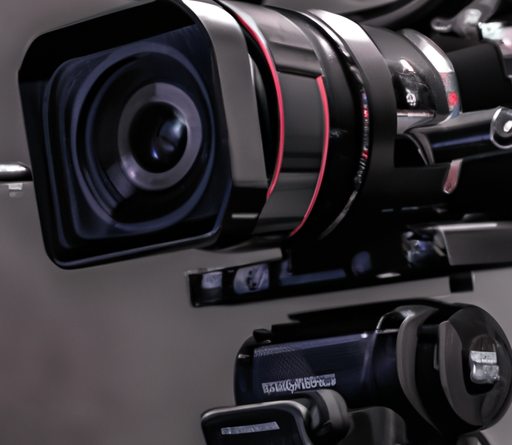
Are you tired of producing low-quality videos that don’t capture your audience’s attention? If you’re looking to captivate your viewers and take your video production to the next level, then this article is for you. Discover practical tips and techniques that will help you improve the production quality of your videos, from lighting and sound to editing and storytelling. With these expert insights, you’ll be able to create videos that not only look professional but also engage and resonate with your audience. Say goodbye to lackluster videos and hello to captivating content that leaves a lasting impression.
Invest in a High-Quality Camera
When it comes to improving the production quality of your videos, one of the most important investments you can make is in a high-quality camera. A good camera can make a world of difference in the overall look and feel of your videos.
Choose the right type of camera
The first step in selecting a camera is to determine the type that best suits your needs. There are several options to choose from, including DSLR cameras, mirrorless cameras, and camcorders. Each type has its own advantages and disadvantages, so take some time to research and consider what features are most important to you.
Consider the resolution and image quality
Resolution and image quality are crucial factors to consider when selecting a camera. Higher resolutions, such as 4K or even 8K, can provide incredibly sharp and detailed images. However, keep in mind that higher resolutions also require more storage space and may not be necessary if you’re primarily creating content for online platforms.
Opt for cameras with interchangeable lenses
Cameras with interchangeable lenses offer versatility and the ability to achieve different looks and styles. This feature allows you to switch between wide-angle, telephoto, and macro lenses, expanding your creative possibilities. Having a variety of lenses at your disposal will enable you to capture different shots with ease.
Consider the sensor size and low-light performance
The size of the camera sensor plays a critical role in the quality of the images and videos it produces. Larger sensors generally result in better low-light performance and dynamic range. If you frequently shoot in challenging lighting conditions or want to capture more detail in your videos, opt for a camera with a larger sensor.
Use Proper Lighting Techniques
Good lighting is vital for creating high-quality videos. It can elevate the overall look, enhance the mood, and draw attention to the subjects of your video.
Understand the importance of good lighting
Lighting sets the tone for your video, enhances its visual appeal, and helps capture the details you want viewers to see. It can make the difference between a dull, poorly lit video and one that is captivating and professional-looking. Poorly lit videos can appear grainy, washed out, or overly dark, while well-lit videos appear crisp, vibrant, and polished.
Invest in lighting equipment
To achieve professional-looking lighting, you may need to invest in some lighting equipment. This can include softboxes, LED panels, umbrellas, or reflectors. These tools will help you control the intensity, direction, and color of the light, allowing you to create the desired atmosphere for your videos.
Position the lights effectively
Knowing where to position your lights is crucial in achieving the desired lighting effect. The key light is the main light source and should typically be placed at a 45-degree angle to your subject. Fill lights can be used to soften shadows, and backlighting adds depth and separation from the background. Experiment with different arrangements to find the best lighting setup for your specific needs.
Utilize natural light when possible
While lighting equipment offers control and consistency, natural light can also be a valuable asset in enhancing your videos. Shooting near windows or outdoors during the golden hour (the period shortly after sunrise or before sunset) can provide a soft, flattering light. However, be mindful of the changing light conditions and ensure your subject is well-illuminated throughout the entire shoot.
Choose an Appropriate Location
The location you choose to shoot your videos can greatly impact the production quality and overall success of your content.
Select a setting that suits your video’s theme
The location should align with the theme and content of your video. Whether it’s a cozy living room, a professional office, or a picturesque outdoor location, the setting should complement and enhance what you’re trying to convey to your audience.
Consider the acoustics and background noise
Good audio quality is just as important as high-quality visuals. When selecting a location, pay attention to the acoustics and background noise. Avoid locations with excessive echo, ambient noise, or distractions that may negatively impact your video. Consider using a separate microphone or audio recording equipment to capture clear sound.
Ensure the location is well-lit
Lighting is not only important for video quality but also for showcasing the location effectively. Ensure the location has sufficient lighting or bring your own lighting equipment to properly illuminate the space. This will help your viewers see the details of the location and create a more visually appealing video.
Avoid distracting elements
When choosing a location, be mindful of any distracting elements that may detract from the focus of your video. This can include cluttered backgrounds, busy patterns, or objects that don’t align with the overall vibe you’re trying to create. Keep the background clean and visually appealing to maintain your viewers’ attention.
Focus on Framing and Composition
Framing and composition play a significant role in creating visually appealing and engaging videos.
Utilize the rule of thirds
The rule of thirds is a fundamental principle in photography and videography. It involves dividing the frame into a grid of horizontal and vertical thirds, creating four points where the lines intersect. Placing your subject or important elements along these intersecting points can add balance and interest to your shots.
Balance the visual elements
Whether you’re shooting a person, an object, or a scene, strive for balance in your composition. Consider the size, shape, and placement of the elements within the frame. Distribute visual weight evenly to create a pleasing, balanced image.
Create depth and dimension
Adding depth to your shots can make them more visually dynamic. Experiment with techniques such as incorporating layers, leading lines, or placing objects in the foreground, middle ground, and background. This will give your videos a sense of depth and make them appear more immersive.
Experiment with different angles and perspectives
Don’t be afraid to get creative and try different angles and perspectives. Experiment with high and low angles, overhead shots, or even unique camera movements to add variety to your videos. Different angles can evoke different emotions and help you capture your subject from new and interesting viewpoints.
Capture High-Quality Audio
Good audio is crucial for maintaining viewers’ attention and conveying your message clearly. Invest time and effort in capturing high-quality audio to complement your visuals.
Invest in a good microphone
Investing in a good microphone can significantly improve the audio quality of your videos. A dedicated microphone, such as a shotgun or lapel microphone, can capture clearer and more focused sound compared to the built-in microphone on your camera or smartphone.
Choose the right microphone type
Different microphones are suited for different scenarios. Shotgun microphones are ideal for capturing sound from a distance, while lapel microphones are excellent for interviews or capturing dialogue. Consider the specific requirements of your videos and choose a microphone that best suits your needs.
Reduce background noise
Background noise can be distracting and detract from the overall quality of your videos. To reduce unwanted noise, ensure you’re in a quiet environment, away from sources such as fans, air conditioners, or bustling streets. If necessary, use noise reduction techniques or software during the editing process to remove or minimize background noise.
Use audio editing software for post-production
In addition to capturing high-quality audio during filming, using audio editing software during post-production can further enhance the sound quality. Edit and mix your audio tracks, adjust volume levels, remove unwanted noise, and add any necessary effects to achieve the desired audio quality for your videos.
Plan and Script your Videos
Planning and scripting your videos can greatly improve the overall quality and cohesiveness of your content.
Outline your video content
Before hitting the record button, take the time to outline the content and structure of your video. Define the key points you want to cover and create a logical flow to guide your viewers through the information. This will help you stay organized and ensure you deliver a clear message.
Create a compelling story or narrative
Storytelling can add depth and captivate your audience. Think about the story or narrative you want to convey in your videos. Whether it’s a personal anecdote, an informative journey, or an engaging narrative, a well-crafted story can make your videos more memorable and impactful.
Write a clear and concise script
A script acts as a roadmap for your video. It helps you stay on track, ensures you cover all the necessary points, and prevents unnecessary rambling. Write a script that is clear, concise, and engaging, keeping in mind your target audience and the specific goals of each video.
Practice and rehearse before recording
Once you have your script, take the time to practice and rehearse your delivery. This will help you become more comfortable with the content, improve your timing, and reduce the chances of stumbling over your words during recording. Practice makes perfect, and the more prepared you are, the smoother your videos will be.
Utilize Professional Editing Software
Editing is a crucial step in the video production process. Utilizing professional editing software can greatly enhance the quality of your videos and bring your vision to life.
Choose the right editing software
There are numerous video editing software options available, ranging from beginner-friendly to more advanced professional tools. Consider your skill level, budget, and specific editing needs when choosing the software that best suits you. Popular choices include Adobe Premiere Pro, Final Cut Pro, and DaVinci Resolve.
Learn the basics of video editing
Familiarize yourself with the basics of video editing, even if you’re a beginner. Understand essential concepts such as timeline editing, cutting, trimming, and transitions. Learning how to effectively organize your footage, apply effects, and sync audio and video will help you create polished and seamless videos.
Use transitions and effects tastefully
Transitions and effects can enhance the visual appeal and flow of your videos. However, use them sparingly and purposefully. Overusing transitions or applying excessive effects can make your videos appear amateurish or gimmicky. Choose transitions and effects that complement your content and enhance the viewer’s experience, rather than distract from it.
Color correct and enhance the video
Color correction and grading can transform the overall look and mood of your videos. Experiment with adjusting the color balance, saturation, contrast, and exposure to create a more visually appealing final product. Pay attention to skin tones, natural colors, and overall consistency throughout your videos to maintain a polished and professional appearance.
Create Engaging and Informative Content
The content of your videos plays a significant role in capturing and retaining viewers’ attention. Focus on creating content that is informative, visually appealing, and engaging.
Define your target audience
Understanding your target audience is essential in creating content that resonates with them. Consider their interests, needs, and preferences when planning your video topics and delivery. Tailoring your content to your specific audience will help you establish a connection and increase viewer engagement.
Research and plan your video topics
To ensure your videos are informative and valuable to your audience, conduct thorough research on your chosen topics. Stay up to date with industry trends, seek inspiration from other creators, and brainstorm unique angles to present your content. Planning ahead will help you deliver well-researched, relevant, and thought-provoking videos.
Make your content visually appealing
Humans are visual creatures, and attention spans are limited. To capture and maintain viewers’ attention, make your content visually appealing. This includes using eye-catching graphics, incorporating dynamic visuals, and utilizing effective storytelling techniques to keep your audience engaged.
Deliver clear and concise information
In an age of information overload, delivering clear and concise information is vital. Keep your videos focused, avoid unnecessary tangents, and present information in a straightforward and understandable manner. This will ensure your viewers grasp the key points and take away the information they came for.
Improve your Acting or Presentation Skills
Whether you’re appearing on camera as the host or sharing your knowledge and expertise, honing your acting or presentation skills can significantly enhance the quality of your videos.
Practice your delivery
Good delivery is crucial for maintaining viewer engagement. Practice your delivery style, experiment with pacing, and work on your timing. Aim for a natural and conversational tone, as if you’re speaking directly to your audience.
Maintain good posture and body language
Your body language speaks volumes on camera. Maintain good posture, project confidence, and use appropriate hand gestures or body movements to emphasize your points. Pay attention to facial expressions and maintain eye contact with the camera or your audience to establish a connection.
Control your voice tone and volume
Varying your voice tone and volume can add depth and emphasis to your delivery. Experiment with different vocal techniques to convey your message effectively. Be mindful of your enunciation, pace, and volume to ensure your viewers can clearly understand and follow along.
Engage with the camera or audience
Engaging with your viewers is essential for building a connection and retaining their attention. Look directly into the camera lens as if you’re speaking to a friend, ask questions, or encourage audience participation. Foster a sense of community and interaction to make your viewers feel involved and invested in your content.
Pay Attention to Details
Paying attention to the finer details can greatly improve the quality of your videos and create a more professional and polished end product.
Check for continuity errors
Continuity errors can be distracting for viewers and detract from the overall quality of your videos. Pay attention to details such as positioning of objects, costumes, or hairstyles to maintain consistency throughout your shots. Keep an eye out for any inconsistencies during filming and make necessary adjustments to ensure a smooth viewing experience.
Ensure proper focus and exposure
Proper focus and exposure are critical for producing clear and professional-looking videos. Take the time to adjust the settings on your camera to ensure your subject is in focus and properly exposed. Monitor the shot during filming to spot any issues and make necessary adjustments to achieve optimal image quality.
Remove bloopers and irrelevant footage
Editing is the perfect opportunity to remove any bloopers or irrelevant footage that doesn’t contribute to the overall quality or message of your videos. Trim clips, cut out mistakes, and remove any segments that are off-topic or unnecessary. Keep your videos concise and focused to maintain viewer engagement.
Pay attention to video and audio synchronization
The synchronization of video and audio is crucial for a seamless viewing experience. Ensure that the audio matches the actions or dialogue on screen. Pay attention to any discrepancies or delays during filming and make necessary adjustments during the editing process to achieve perfect synchronization.
By investing in a high-quality camera, utilizing proper lighting techniques, choosing appropriate locations, focusing on framing and composition, capturing high-quality audio, planning and scripting your videos, utilizing professional editing software, creating engaging and informative content, improving your acting or presentation skills, and paying attention to details, you can significantly improve the production quality of your videos. Remember to always strive for continuous improvement and adapt to the ever-evolving landscape of video production. Happy filming!






